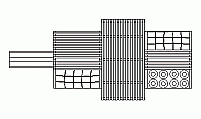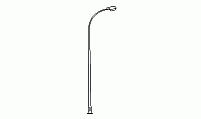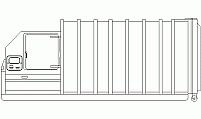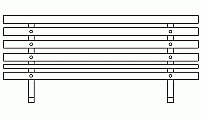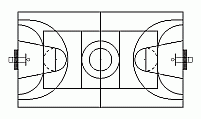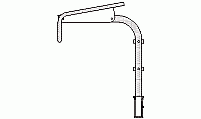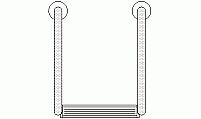CAD Blocks categories
 3D models
3D models home furniture
home furniture sanitary ware - bathrooms
sanitary ware - bathrooms professional equipment
professional equipment doors and windows
doors and windows people and animals
people and animals plants and trees
plants and trees vehicles - transports
vehicles - transports architectural details
architectural details mechanical - electrical
mechanical - electrical urban planning - civil works
urban planning - civil works safety health construction
safety health construction accessible design
accessible design drawing sheet
drawing sheet signals
signals construction machinery
construction machinery accessories and objects
accessories and objects maps and street maps
maps and street maps
Public Water Fountain CAD Block in Plan View

size: 8 kb
category: street furniture
related categories:
description: Top-down view of a decorative public water fountain with concentric ornamental elements resembling petals, central water outlet, and drainage system.
file extension: .dwg CAD - AutoCAD software
Ornamental Water Fountain Design for Public Spaces
Detailed Structure of the Hydration Fountain
This hydration fountain showcases an intricate design inspired by natural patterns such as leaves or petals. The central component is a water outlet that dispenses clean drinking water, ensuring accessibility and functionality. Surrounding the outlet is an overflow area that collects excess water, directing it to a concealed drainage system to prevent pooling or contamination. This overflow mechanism is designed to handle high volumes of water during periods of heavy use.
The decorative concentric shapes serve both an aesthetic and functional purpose, guiding water outward while enhancing the fountain’s visual appeal. Variations of this type of public hydration feature often include additional spouts, LED lighting, or textured surfaces. These features make the fountain suitable for diverse applications, from urban landscapes to private garden installations. The design ensures durability while maintaining the natural, ornamental appearance that blends seamlessly into public spaces.
Standard Dimensions and Measurements
Public drinking fountains designed for accessibility must adhere to specific dimensions to ensure their usability by all individuals, including those with disabilities and children. According to ADA standards, the height of the central water spout should not exceed 36 inches (91.4 cm) from the ground, making it suitable for wheelchair users. For fountains specifically designed for children, the spout height is typically 30 inches (76.2 cm) or less, allowing younger users to drink comfortably without assistance. These standards promote inclusivity and ease of use in public spaces.
The diameter of the fountain basin is generally compact, ranging from 12 inches (30.5 cm) to 24 inches (61 cm). This size facilitates direct access to the water stream without requiring users to lean excessively. The base is often made with a solid foundation, such as concrete, to ensure stability and durability. These dimensions are in line with the recommendations from manufacturers specializing in public water dispensers, ensuring compliance with modern urban design needs.
Installation and Material Considerations
- What materials are commonly used for hydration stations?
- Public fountains are typically made from durable materials like cast iron, stainless steel, reinforced concrete, and natural stone. These materials ensure resistance to weather conditions, vandalism, and wear, making them ideal for outdoor environments. Polished finishes or coatings can also be applied to enhance their longevity and aesthetics.
- How is an outdoor water feature installed?
- Installation requires a solid foundation, usually made of concrete, to support the fountain’s weight and prevent settling over time. The plumbing system is connected to a municipal water supply, and anchoring mechanisms are used to secure the fountain to the base, ensuring safety and stability.
- What type of drainage system is recommended?
- Efficient drainage systems include concealed piping, grates, or catch basins that direct water away from the fountain area. This prevents water buildup, ensures safety, and maintains cleanliness around the fountain. Drainage must be regularly inspected to prevent blockages.
- What maintenance is required for public drinking fountains?
- Maintenance includes routine cleaning of surfaces, testing the water quality to ensure safety, and inspecting plumbing and drainage systems for leaks or clogs. Regular upkeep prolongs the lifespan of the fountain and maintains its functionality.
- Are public fountains ADA-compliant?
- Yes, many fountains are designed with ADA compliance in mind, including accessible spout heights and lever-activated mechanisms. These features ensure usability for individuals with disabilities while meeting regulatory standards.
Advantages of Ornamental Hydration Features
Ornamental public fountains serve a dual purpose: providing clean drinking water and enhancing the aesthetic appeal of public spaces. These hydration stations encourage outdoor activity by offering easily accessible water in parks, plazas, and streetscapes. Their presence promotes public health and well-being, especially in high-traffic pedestrian areas.
Compared to simpler drinking fountains, decorative models add significant value to urban landscapes. The incorporation of durable materials and advanced water management systems, such as overflow channels and filtration mechanisms, ensures that these features remain practical and visually appealing. Their versatility makes them suitable for a variety of environments, from modern cityscapes to historical landmarks.
History and Global Adaptations of Drinking Fountains
Drinking fountains date back to ancient times, where they were communal gathering points for water access. Early designs were simple basins, but as societies advanced, these features became more intricate. During the Renaissance and Victorian eras, fountains often included elaborate sculptures and were symbols of wealth and artistry. Today, public fountains combine functionality with modern aesthetics.
Across the world, public water features have evolved to reflect local cultures and technologies. For example, Japanese bamboo fountains, European marble hydration stations, and solar-powered dispensers in eco-friendly regions demonstrate the adaptability of these systems. Regardless of their form, they remain essential for providing potable water while enhancing the visual identity of public spaces.










